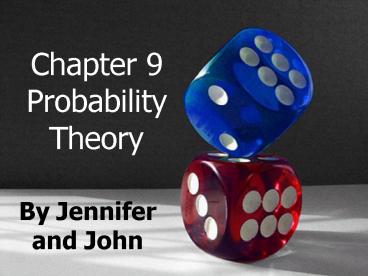Chapter 9 Probability Theory
1 / 35
Title:
Chapter 9 Probability Theory
Description:
Studied birth and death records and was able to figure the number of people ... Because men were subject to death from occupational accidents, diseases, and war, ... –
Number of Views:770
Avg rating:3.0/5.0
Title: Chapter 9 Probability Theory
1
Chapter 9Probability Theory
- By Jennifer and John
2
Graunt
- (1620-1674)
- Bills of Mortality (1662)
- Studied birth and death records and was able to
figure the number of people dying from the
plague. - Started as an Empirical Science.
3
Graunt
- Because men were subject to death from
occupational accidents, diseases, and war, the
number of men and women of marriageable age were
about equal. - His work was the first to analyze statistics.
4
Graunt
- Graunts work led to the development of actuarial
science, which is used by life insurance
companies.
5
Huygens
- (1629 1695)
- Wrote De Ratiociniis in Ludo Aleae (1657) the
value(price) of the chance. - For half a century, it was the only text
available on probability theory.
6
Cardan
- (1501 1576)
- Avid Gambler
- Gambling is a source to which probability theory
owes its birth and development. - Wrote treatise Liber Deludo Aleae (Book on
Games of Chance, 1550).
7
Cardan
- First historical record of probability theory.
- Wasnt published until 1663.
- Gave a rough definition of probability as a ratio
of equally likely events.
8
Cardan
- Transition was made from empiricism to the
theoretical concept. - In doing so, Cardan probably became the real
father of modern probability theory.
9
The Problem of PointsTartaglia vs. Cardan
- One of the earliest problems concerns the fair
division of stakes between two players when the
game is interrupted before its conclusion. - The problem is so difficult that its solution by
Pascal in 1654 may well be considered a decisive
breakthrough in the history of probability theory.
10
Blaise PascalThe Greatest Might-Have-Been
- (1623 1662)
- Linked with Fermat as one of the joint founders
of probability theory.
11
Blaise PascalThe Greatest Might-Have-Been
- (1623 1662)
- Linked with Fermat as one of the joint founders
of probability theory.
12
Blaise PascalAn Exceptionally Versatile Man
- Gifted writer author of the first great prose
classic in the modern French language, Lettres
Provinciales and Pensées. - Religious Philosopher
- A rebellious curiosity for math
- Experimental Physicist
13
Blaise Pascal
- Essay pour les coniquies (1640) one of the most
fruitful pages in mathematics. - Traité du Triangle Arithmétique (1654)
discoveries relating to binomial coefficients.
14
Blaise Pascal
- Pascals work on the cycloid led to his letter
Traité des sinus du quarte de circle (1658). This
served as immediate inspiration for Leibniz in
his invention of the differential and integral
calculus.
15
Creating the Cycloid
16
- The year 1654 is a landmark in the history of
probability theory.
- Bothered by certain problems in gambling, a
French nobleman sent some questions to Pascal.
- Rolls of the dice Originally considered by
Cardan who based his study on the premise that
there are fundamental scientific principles
governing the likelihood of achieving the double
six outside of mere luck or chance.
17
Pascals Arithmetic Triangle? (1623 1662)
- Chinese Triangle (1304)
18
The arithmetic triangle, now generally known as
Pascals triangle, is an infinite numerical table
in triangular form.
Binomial Probability Probability when there are
only two possilble outcomes.
19
Uses of Pascals Triangle
- Coefficients in the binomial expansion of (x
y)n. - Binomial Probability
- (xy)2 1x2 2xy 1y2
- (xy)3 1x3 3x2y 3xy2 1y3
- (xy)4
- 1x4 4x3y 6x2y2 4xy3 1y4
20
(xy)2 1x2 2xy 1y2(xy)3 1x3
3x2y 3xy2 1y3
21
Coin Toss
22
Pascals Triangle Worksheets
- Pascals Triangle Excel program
- Pascals Triangle quick calculator
23
Fermat
- (1601 - 1665 )
- Along with Pascal, Fermat supplied vital links in
a chain of reasoning that gave us probability
theory as we know it.
24
Buffon
- (1707 1788)
- Author of 36 volume Histoire Naturelle.
- At 20 discovered the binomial theorem.
- Posed the needle problem.
25
Buffon-Laplace Needle Problem
- Parallel Lines
- Square grid
26
Laplace
- (1749 1827)
- It was largely Laplace who went on to broaden the
mathematical treatment of probability to areas of
scientific research well beyond the games of
chance.
27
Laplace
- (1749 1827)
- It was largely Laplace who went on to broaden the
mathematical treatment of probability to areas of
scientific research well beyond the games of
chance. - Mécanique Céleste
28
Mary Fairfax Somerville
- (1780 1870)
- Extraordinary, self educated Scotswoman who
studied the treatise, Mécanique Céleste, in
Edinburgh.
29
Mary Fairfax Somerville
- Mécanique Céleste was Laplaces
great achievement.
- It completed the work Newton had begun. It
showed that all the movements of the planetary
system were deductible from the law of
gravitation.
- Laplace is said to have observed that Mary
Somerville was the single woman who understood
his great treatise.
30
James Bernoulli
- (1654 1705)
- From a family of eight mathematicians.
- Started life in the ministry.
- Ars Conjectandi contains practically all the
standard results on permutations and combinations
in the form in which they are still expressed.
31
Marquis de LHospital
- (1661 1704)
- French Nobleman
- Paid for tutelage by John Bernoulli.
- Published Bernoullis work as his own.
- Has a famous math concept named after him.
- LHospitals Rule.
32
Abraham de Moivre
- (1667 1754)
- French Protestant
- Pioneered the development of analytic geometry
and the theory of probability. - The Doctrine of Chances
- Predicted the day of his own death.
33
Works Consulted
- Burton, David M., The History of Mathematics An
Introduction, 5th ed., New York, McGraw-Hill,
2003. - See Web Site List.
34
Probability Quiz
Hit me!!!
35
Thank you





![❤[PDF]⚡ The Mathematical Theory of Bridge: 134 Probability Tables, Their Uses, Simple](https://s3.amazonaws.com/images.powershow.com/10085015.th0.jpg?_=202407240412)

























